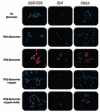Cell-penetrating TAT peptide in drug delivery systems: proteolytic stability requirements
- PMID: 21438724
- PMCID: PMC3482480
- DOI: 10.3109/10717544.2011.567310
Cell-penetrating TAT peptide in drug delivery systems: proteolytic stability requirements
Abstract
The stability and activity of the HIV cell-penetrating TAT peptide (TATp) on the surface of TATp-modified micelles and liposomes in relation to its proteolytic cleavage was investigated. TATp moieties were attached to the surface of these nanocarriers using TATp modified with a conjugate of phosphatidyl ethanolamine with a 'short' PEG (PEG-PE). Following pre-incubation with trypsin, elastase, or collagenase, the proteolytic stability of TATp on the surface of these modified carriers was studied by HPLC with fluorescence detection using fluorenylmethyl chloroformate (FMOC) labeling. All tested enzymes produced a dose-dependent cleavage of TATp as shown by the presence of TATp Arg-Arg fragments. Inhibition of TATp cleavage occurred when these TATp-micelles were modified by the addition of longer PEG-PE blocks, indicating an effective shielding of TATp from proteolysis by these blocks. TATp-modified carriers were also tested for their ability to accumulate in EL-4, HeLa, and B16-F10 cells. Trypsin treatment of TATp-modified liposomes and micelles resulted in decreased uptake and cell interaction, as measured by fluorescence microscopy and fluorescence-activated cell sorting techniques. Furthermore, a decrease in the cytotoxicity of TATp-modified liposomes loaded with doxorubicin (Doxil) was observed following trypsin treatment. In conclusion, steric shielding of TATp is essential to ensure its in vivo therapeutic function.
Figures





References
-
- Abes R, Arzumanov AA, Moulton HM, Abes S, Lvanciva GD, Lversen PL, Gait MJ, Lebleu B. Cell-penetrating-peptide-based delivery of oligonucleotides: an overview. Biochem Soc Trans. 2007;35:775–9. - PubMed
-
- Bae Y, Kataoka K. Intelligent polymeric micelles from functional poly (ethylene glycol)-poly (amino acid) block copolymers. Adv Drug Deliv Rev. 2009;61:768–84. - PubMed
-
- Elmquist A, Langel U. In vitro uptake and stability study of pVEC and its all-D analog. Biol Chem. 2003;384:387–93. - PubMed
Publication types
MeSH terms
Substances
Grants and funding
LinkOut - more resources
Full Text Sources
Other Literature Sources
Miscellaneous
